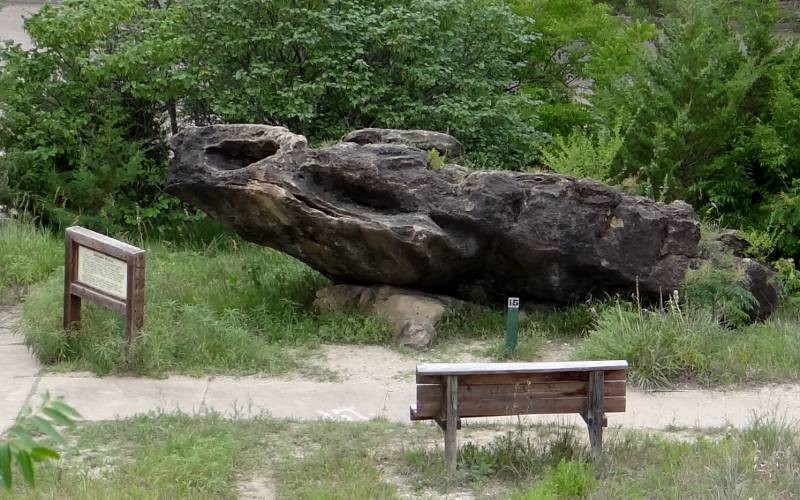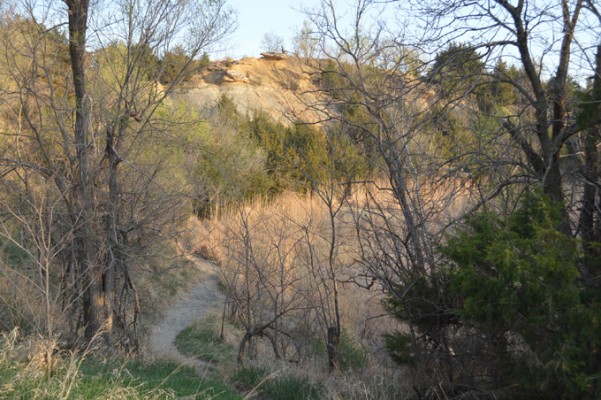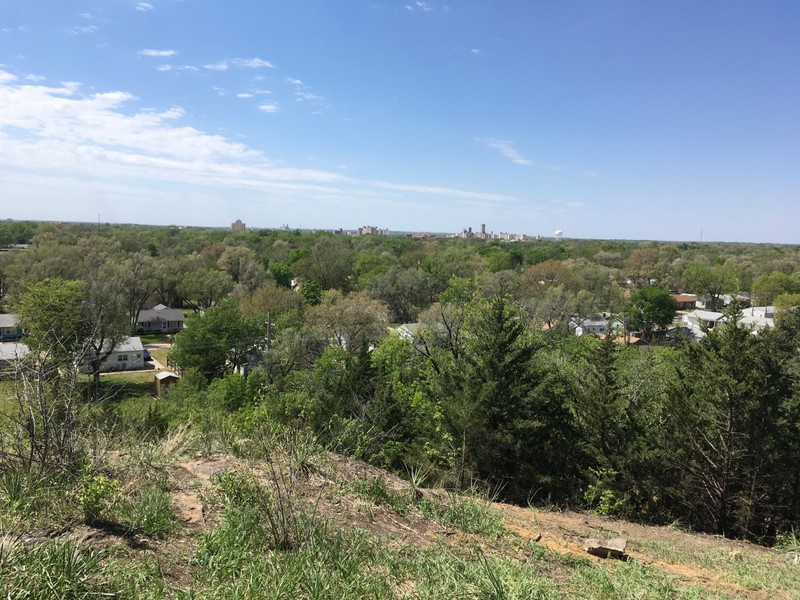Indian Rock Park
Introduction
Text-to-speech Audio
Indian Rock Park is named after a battle that occurred here in 1857 between Great Plains Native American tribes from eastern and western Kansas to determine who would maintain control over area lands and hunting grounds around present-day Salina. There are 35 acres available for hiking and exploring along trails as well as a small pond, prairie grass, and a view overlooking Salina and the Smoky Hill River. There are restrooms, a lodge which must be reserved, and two shelters available on a first come/first served basis.
Images
The Indian Rock which served as the landmark for the 1857 Native American battle over hunting ground between the eastern tribes (Delaware and Pottawatomie) and western tribes (Cheyenne, Sioux, and Arapahoe) of Kansas.

As part of an Eagle Scout project, a 1.2 mile hiking trail sign was posted which displays the best hiking trail through the park. One can venture off the trail and do limited rock climbing.

This is a view of the park from the west looking up at Indian Rock hill. There is a splendid view of Salina and the Smoky Hill River from the top of the hill. The small pond, which provided sand, gravel, and clay for brick making is in the foreground

Another view of Salina from the top of Indian Rock Park.

Backstory and Context
Text-to-speech Audio
The park is the site of a battle between two eastern Kansas tribes, the Delaware and Pottawatomie, and three western Kansas tribes, the Cheyenne, Sioux, and Arapahoe. These Native American tribes had an ongoing dispute over hunting lands in Kansas. The Delaware and Pottawatomie Tribes, known collectively as the eastern tribes, were friendly towards the white settlers. They claimed the land west of Salina towards what is now Ellsworth, Kansas, as their hunting ground. The Cheyenne, Sioux, and Arapahoe, known collectively as the western tribes, were not friendly to white settlers or the eastern tribes. They believed that the same lands around Salina all the way to the Rocky Mountains were their hunting grounds.
The eastern tribes were on a big hunt in the disputed hunting land, about 20 miles west of Salina, when the western tribes attacked them near Spring Creek. The western tribes pushed the eastern tribes back towards the east in a running fight towards Dry Creek just west of Salina. The tribes engaged in battle again at Dry Creek until the eastern tribes retreated to a hill east of the Saline River - what is now known as Indian Rock Park.
The eastern tribes knew that they needed reinforcements. They sent a runner to the Kansa Tribe at Council Grove – about 65 miles away. The runner reached the Kansa Tribe, and the Kansa reinforcements came within two days, bringing rifles with them. The western tribes attacked the reinforced and well-armed eastern tribes. They were killed in considerable numbers and retreated westward, giving the eastern tribes a significant victory. The battle ended the western tribes’ hunting ground claim and the inter-tribal conflict. The eastern tribes’ victory ended the strife between the Native American tribes, bringing peace to the region and making it possible for U.S. residents and European immigrants to settle in the Salina area.
In the late 1800s and early 1900s, the land surrounding the battle area was the site of the Salina Brick and Tile Company. A small pond remains from the company’s rock and gravel extractions. The company deeded the land to the Saline County Historical Society in 1922. The Society, in turn, deeded the land to the City of Salina that same year with the provision that it be perpetually cared for as a historical site recognizing the 1857 Native American battle fought at Indian Rock. It is now part of the Salina Park system.
Sources
Anonymous, “Once Scene of One of Bloodiest Tribal Battles Known in Warfare of the Plains”, The Salina Evening Journal (February 10, 1923), page 8.
Austin, Whitley, “Love Affairs with Parks a Tribute to Kansas Spirit”, The Salina Journal, (August 30, 1987), page 4.
Blakeslee, Don, “In No Distant Day: The Battle of Indian Rock and the Founding of Salina”, 2004.
Brown, May Belleville, “The Battle of 1858: Famous Indian Encounter on Hills East of Salina”, The Evening Salina Journal (January 2, 1923).
Burke, Bill, “Salina Built on Indian War Site”, The Salina Journal, (December 4, 1957).
Chesky, Bob, “Battle of Indian Rock Played an Important Part in Salina’s History”, The Salina Journal, June 26, 1955.
Johnson, David, “Indian Rock – Salina, KS, History Hawks”, Wordpress.com Weblog, October 8, 2009, https://historyhawks.wordpress.com/2009/10/08/indian-rock-salina-ks.
Miller, Anna-Lora, Indian Rock, undated, “History prepared for Daughters of the American Revolution Indian Rock Plaque Dedication Ceremony” Salina Centennial Commission Book 1958.
Stokes, Keith, “Indian Rock Park and Smoky Hills River Falls”, accessed 1 February 2019, 11:40, http://www.kansastravel.org/indianrockpark.htm.
The Salina Journal, “Salina has Colorful 143-Year History”, The Salina Journal, August 5, 2001, page 6.
Indian Rock Park Shelter Reservations can be made through the Salina Parks and Recreation Office, http://www.salina-ks.gov/content/18394/18534/20376/22688.aspx. For more information, call the Parks & Recreation office at (785) 309-5765.
